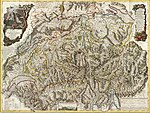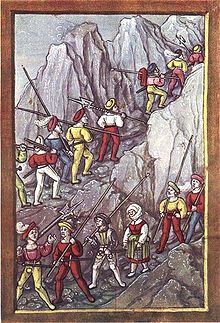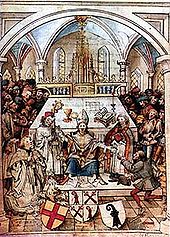Growth of the Old Swiss Confederacy
| History of Switzerland |
|---|
 |
| Early history |
|
| Old Swiss Confederacy |
|
| Transitional period |
|
| Modern history |
|
| Timeline |
| Topical |
|
|
|
The
With the rise of the
By 1460, the confederates controlled most of the territory south and west of the
Two similar federations sprang up in neighboring areas in the Alps in the 14th century: in the

Territorial development

Under the
When
This time of turmoil prompted the Waldstätten to cooperate more closely, trying to preserve or regain their immediacy. The first alliance started in 1291 when Rudolph bought all the rights over the town of

Nucleus

The
King
In the struggle for the crown of the
The
wa böse Türnli waren, die brachen sy vnd viengen ze Uere am ersten an die hüser brechen |
wherever there were hostile forts (towers), they broke (slighted) them and first began in Uri to break these buildings[5] |
The text names
The Burgenbruch was long seen as historical, substantiated by the numerous ruined castles in Central Switzerland, but archaeological excavations have shown that these castles were abandoned gradually, not during a sudden uprising, during the period of roughly 1200 to 1350. By the 1970s, the "demythologization" of the foundational period of the Confederacy was at its peak, and the default view was to regard the reports of the late-15th-century chronists as essentially legendary. Since the late 1970s, systematic surveys of medieval castles in Central Switzerland have shown that a number of castles were indeed destroyed during the early 14th century, so that a possible historical nucleus of the Burgenbruch accounts may be granted, even though the destruction of these forts in itself was of limited military import and could not have resulted in a lasting political change.[7]
Expansion to the Acht Orte
Subsequently, the three communities (their territories did not yet correspond to the areas of the modern-day

The confederacy had signed "perpetual" pacts with both Glarus and Zug in 1352,[3] and thus, even if these pacts apparently were disregarded only a few years later. This date is often considered the entry of these two cantons into the confederation despite their remaining under Habsburg rule for a few more years.[8]
In the west, the Vier Waldstätten had already formed an alliance with the city of
This alliance of the Eight Cantons was not a homogeneous state but rather a conglomerate of eight independent cities and lands, held together not by one single pact but by a net of six different "eternal" pacts, none of which included all eight parties as signatories. Only the three Waldstätten Uri, Schwyz, and Unterwalden were part of all these treaties. All eight parties would still pursue their own particular interests, most notably in the cases of the strong cities of Zürich and Bern. Zürich was also part of an alliance of cities around
An external threat during this time arose in the form of the Guglers, marauding mercenary knights from France who were beaten back under the leadership of Bern in December 1375.[11]
Consolidation
In 1364, Schwyz reconquered the city and land of Zug and renewed the alliance the following year. In the 1380s,
The loose federation of states was reinforced by additional agreements amongst the partners. In the Pfaffenbrief of 1370, the signatory six states (without Bern and Glarus) for the first time expressed themselves as a territorial unity, referring to themselves as unser Eydgnosschaft ("our confederacy"). They assumed in this document authority over clericals, subjecting them to their worldly legislation. Furthermore, the Pfaffenbrief forbade feuds and the parties pledged to guarantee the peace on the road from Zürich to the St. Gotthard pass. Another important treaty was the Sempacherbrief in 1393. Not only was this the first document signed by all of the Eight Cantons (plus the associated Solothurn), but it also defined that none of them was to unilaterally start a war without the consent of all the others.
Beginning in 1401, the confederates supported the
Emperor Sigismund placed the imperial ban on Frederick IV in 1415, who had sided with Antipope John XXIII at the Council of Constance, and encouraged others to take over the duke's possessions, amongst which was the Aargau. After being granted far-reaching privileges by the emperor (all eight cantons became immediate) and a decree that placed the ban over the peace treaty of 1412, the confederates conquered the Aargau.[12] A large part became Bernese, while the County of Baden was subsequently administered by the confederation as a common property until 1798. Only the Fricktal remained a Habsburg possession.

In the Valais, the conflict between the Bishop of Sion and the Duchy of Savoy, which had led to a separation in 1301 (the bishop controlling the upper Valais and the Savoyards the lower part), broke out again. Twice the Savoyards temporarily occupied the whole Valais, but both times they were ultimately defeated. Both peace treaties from 1361 and 1391 restored the status quo of 1301. As a result of these struggles, the villages in the upper Valais organized themselves in the Sieben Zenden ("seven tenths") around 1355, emerging after these wars as largely independent small states, much like the cantons of the Confederacy.
In the
Internal crisis
The relationships between the individual cantons of the confederation were not without tensions, though. A first clash between Bern and the four Waldstätten over the
The
The end of the dynasty of the counts of Toggenburg in 1436 also had effects on the
Further expansion
This section needs additional citations for verification. (July 2017) |
In the second half of the 15th century, the confederation expanded its territory further. In the north, the formerly Habsburg cities of Schaffhausen and Stein am Rhein had become immediate in 1415, with the ban of Frederick IV. The two strategically important cities—they offered the only two fortified bridges over the river Rhine between Constance and Basel—not only struggled with the robber barons from the neighbouring Hegau region but also were under pressure from the Habsburg dukes, who sought to re-integrate the cities into their domain. On June 1, 1454, Schaffhausen became an associate (Zugewandter Ort) of the confederacy by entering an alliance with six of the eight cantons (Uri and Unterwalden did not participate). With the help of the confederates, a Habsburg army of about 2,000 men was warded off east of Thayngen. Stein am Rhein concluded a similar alliance on 6 December 1459.
The city of
Duke
The Swiss also had an interest in extending their influence south of the
Burgundy Wars
The Burgundian Wars were an involvement of confederate forces in the conflict between the

The conflicts culminated in 1474, after duke
As a result of the Burgundian Wars, the dynasty of the
Swiss mercenaries

In the Burgundian Wars, the Swiss soldiers had gained a reputation of near invincibility, and their mercenary services became increasingly sought after by the great European political powers of the time.
Shortly after the Burgundy Wars, individual cantons concluded mercenary contracts, so-called "
Swiss forces soon got involved in the
Dreizehn Orte
Both Fribourg and Solothurn, which had participated in the Burgundy Wars, now wanted to join the confederation, which would have tipped the balance in favour of the city cantons. The rural cantons were thus strongly opposed. In 1477 they marched upon the cities in protest.
At
After isolated bilateral pacts between the leagues in the Grisons and some cantons of the confederation had already existed since the early 15th century, the federation of the Three Leagues as a whole became an associate state of the confederation, in 1498, by concluding alliance agreements with the seven easternmost cantons.
When the confederates refused to accept the resolutions of the
As a direct consequence of the Swabian War the previously associated city states of
as well as the Three Leagues in the Grisons were all associates of the confederation (Zugewandte Orte); the Valais would become an associate state in 1529.Annexation of the Ticino and the Veltlin
The Ticino region consisted of several city-states along the Ticino river. Following the conquest of the region, it was divided into four 'Ticino Bailiwicks' which were under the joint administration of the Thirteen Cantons after 1512. The four bailiwicks were Valle di Maggia (German: Meynthal or Maiental), Locarno (German: Luggarus), Lugano (German: Lugano) and Mendrisio (German: Mendris). The area also included several other territories that were owned by one or more cantons. These included: the Bailiwick of Bellinzona (German: Bellinzona), Blenio (German: Bollenz) and Riviera (German: Reffier) which were owned by Uri, Schwyz, and Nidwalden as well as the bailiwick Leventina (German: Livinental) (owned by Uri) and even the Val d'Ossola (German: Eschental). There were also three Italian-speaking subject areas of the Three Leagues (Bormio, Valtellina and Chiavenna) which were not included in the Ticino Bailiwicks.[23]
Between 1403 and 1422 some of these lands were annexed by forces from Uri, but subsequently lost after the
Some of the land and the town of Bellinzona were annexed by Uri in 1419 but lost again in 1422. In 1499 nearly one and a half centuries of Milanese rule in Bellinzona ended with the invasion of Milan by
Between 1433 and 1438 the Duke of Milan, Aloisio Sanseverino, sat as a feudal lord over Lugano. Under the reign of his heirs in the following decades rebellions and riots broke out, which lasted until the French invasion of 1499.[27]
Myths and legends

The events told in the saga of
The legend of Arnold von Winkelried likewise is first recorded in the 16th century;[29] earlier accounts of the Battle of Sempach do not mention him. Winkelried is said to have opened a breach in the lines of the Austrian footsoldiers by throwing himself into their lances, taking them down with his body such that the confederates could attack through the opening.
Social developments
The developments beginning in about the 13th century had profound effects on the society. Gradually the population of
In the rural areas, people generally had less freedom, but some lords furthered the colonization of remote areas by granting some privileges to the colonists.
As free farmers moved into the mountain valleys, construction and maintenance of the mountain pass roads became possible. In the 12th and 13th centuries, the passes into

Although both poor and rich citizens or peasants had the same rights (though not the same status), not all people were equal. Immigrants into a village or city had no political rights and were called the Hintersassen. In rural areas, they had to pay for their use of the common lands. They were granted equal rights only when they acquired citizenship, which not only was a question of wealth (for they had to buy their citizenship), but they also had to have lived there for some time; especially in the rural areas.[32]
The
Economy
This section needs additional citations for verification. (July 2020) |
The population of the cantons numbered about 600,000 in the 15th century and grew to about 800,000 by the 16th century. The grain production sufficed only in some of the lower regions; most areas were dependent on imports of oats, barley, or wheat. In the Alps, where the yield of grains had always been particularly low due to the climatic conditions, a transition from farming to the production of cheese and butter from cow milk occurred. As the roads got better and safer, a lively trade with the cities developed.
The cities were the marketplaces and important trading centers, being located on the major roads through the Alps.
In the late 15th century, the mercenary services became also an important economic factor. The Reisläuferei, as the mercenary service was called, attracted many young adventurous Swiss who saw in it a way to escape the relative poverty of their homes. Not only the mercenaries themselves were paid, but also their home cantons, and the Reisläuferei, while being heavily criticized already at that time as a heavy drain on the human resources of the confederation, became popular in particular among the young peasants from the rural cantons.
Political organization
Initially, the Eidgenossenschaft was not united by one single pact, but rather by a whole set of overlapping pacts and separate bilateral treaties between various members, with only minimum liabilities. The parties generally agreed to preserve the peace in their territories, help each other in military endeavours, and defined some arbitration in case of disputes. The Sempacherbrief from 1393 was the first treaty uniting all eight cantons, and subsequently, a kind of federal diet, the Tagsatzung developed in the 15th century. The second unifying treaty later became the Stanser Verkommnis in 1481.
The Tagsatzung typically met several times a year. Each canton delegated two representatives; typically this also included the associate states. Initially, the canton where the delegates met chaired the gathering, but in the 16th century, Zürich permanently assumed the chair (Vorort), and Baden became the sessional seat.[33]
The Tagsatzung dealt with all inter-cantonal affairs and also served as the final arbitral court to settle disputes between member states, or to decide on sanctions against dissenting members, as happened in the Old Zürich War. It also organized and oversaw the administration of the commons such as the County of Baden and the neighbouring Freiamt, the Thurgau, in the Rhine valley between Lake Constance and Chur, or those in the Ticino. The reeves for these commons were delegated for two years, each time by a different canton.
Despite its informal character (there was no formal legal base describing its competencies), the Tagsatzung was an important instrument of the eight, later thirteen cantons to decide inter-cantonal matters. It also proved instrumental in the development of a sense of unity among these sometimes highly individual cantons. Slowly, they defined themselves as the Eidgenossenschaft and considered themselves less as thirteen separate states with only loose bonds between.
Maps showing the growth of the Old Swiss Confederacy
-
Territorial development of Old Swiss Confederacy, 1291–1797
-
Switzerland in 1315, just before the Battle of Morgarten.
-
Switzerland in 1385, just before the Battle of Sempach.
-
Switzerland in 1474, just before the Burgundian Wars.
-
Switzerland in 1515, just before the Battle of Marignano.
-
Switzerland in 1536, during theFribourg.
-
Switzerland in the 18th century.
-
Another map of Switzerland in the 18th century.
See also
References
Main sources:
- Im Hof, U.: Geschichte der Schweiz, 7th ed., ISBN 3-17-017051-1.
- Schwabe & Co.: Geschichte der Schweiz und der Schweizer, Schwabe & Co 1986/2004. ISBN 3-7965-2067-7.
Other sources:
- ^ Coolidge, William Augustus Brevoort (1911). . In Chisholm, Hugh (ed.). Encyclopædia Britannica. Vol. 26 (11th ed.). Cambridge University Press. p. 247.
- ^ a b c d e f Coolidge, William Augustus Brevoort (1911). . In Chisholm, Hugh (ed.). Encyclopædia Britannica. Vol. 26 (11th ed.). Cambridge University Press. pp. 248–250.
- ^ a b c d e f g History and Creation of the Confederation to 1353 in German, French and Italian in the online Historical Dictionary of Switzerland.
- ^ Battle of Morgarten and Aftermath in German, French and Italian in the online Historical Dictionary of Switzerland.
- ^ Quoted in Ernst Ludwig Rochholz, Tell und Gessler in Sage und Geschichte. Nach urkundlichen Quellen (1877), p. 119.
- William Denison McCrackan, The rise of the Swiss republic. A history (1892), p. 107.
- ^ W. Meyer et al., Die bösen Türnli: Archäologische Beiträge zur Burgenforschung in der Urschweiz, Schweizer Beiträge zur Kulturgeschichte und Archäologie des Mittelalters, vol. 11, Schweizerischer Burgenverein, Olten / Freiburg im Breisgau, 1984, pp. 192–194.
- ^ Glauser, T. "1352 – Zug wird nicht eidgenössisch". Archived 2004-08-27 at the Wayback Machine. State archive of the Canton of Zug; Tugium 18, pp. 103–115; 2002. (PDF, in German)
- ^ Rickard, J (4 October 2000). "Battle of Laupen, 21 June 1339". Retrieved 2009-02-05.
- ^ Burgdorf War in German, French and Italian in the online Historical Dictionary of Switzerland. Following the 1383–84 attack by Burgdorf on Soloturn, the city was defeated and bought by Bern for 37,800 gulden.
- ISBN 0-345-34957-1.
- ^ Aargau, Aargau becomes part of the Confederation in German, French and Italian in the online Historical Dictionary of Switzerland.
- ^ League of God's House in Romansh, German, French and Italian in the online Historical Dictionary of Switzerland.
- ^ Grauer Bund in Romansh, German, French and Italian in the online Historical Dictionary of Switzerland.
- ^ a b League of the Ten Jurisdictions in Romansh, German, French and Italian in the online Historical Dictionary of Switzerland.
- ^ Raron Quarrel in German, French and Italian in the online Historical Dictionary of Switzerland.
- ^ Old Zurich War in German, French and Italian in the online Historical Dictionary of Switzerland.
- ^ Graubünden in Romansh, German, French and Italian in the online Historical Dictionary of Switzerland.
- ^ Coolidge, William Augustus Brevoort (1911). . In Chisholm, Hugh (ed.). Encyclopædia Britannica. Vol. 24 (11th ed.). Cambridge University Press. p. 4.
- ^ Sieber-Lehmann, C. The Burgundy Wars in German, French and Italian in the online Historical Dictionary of Switzerland.; 18 January 2005.
- ^ "History of the Pontifical Swiss Guards". Vatican City. Accessed 9 February 2009.
- ^ Information from the Glacier Garden in Lucerne Archived 2009-03-05 at the Wayback Machine accessed 9 February 2009
- ^ Italian Bailiwicks in German, French and Italian in the online Historical Dictionary of Switzerland.
- ^ a b c Coolidge, William Augustus Brevoort (1911). . In Chisholm, Hugh (ed.). Encyclopædia Britannica. Vol. 26 (11th ed.). Cambridge University Press. pp. 933–934.
- ^ "Bellinzona joins the Confederation". Bellinzona. Archived 2009-05-01 at the Wayback Machine. Accessed 17 July 2008.
- ^ Bellinzona-The Middle Ages in .php German, .php French and .php Italian in the online Historical Dictionary of Switzerland.
- ^ Lugano – During the Middle Ages in German, French and Italian in the online Historical Dictionary of Switzerland.
- ISBN 3-471-77168-9.
- ^ Swissworld.org Confederate victories undermine the power of the nobility. Accessed 5 February 2009.
- ^ Basel City, Population in German, French and Italian in the online Historical Dictionary of Switzerland.
- ^ a b c Niklaus Flüeler; Roland Gfeller-Corthésy (1975). Die Schweiz vom Bau der Alpen bis zur Frage nach der Zukunft: ein Nachschlagewerk und Lesebuch, das Auskunft gibt über Geographie, Geschichte, Gegenwart und Zukunft eines Landes (in German). Migros-Genossenschafts-Bund. p. 88. Retrieved 2 June 2010.
- ^ Holenstein, A.: Hintersassen in German, French and Italian in the online Historical Dictionary of Switzerland.; September 5, 2005.
Further reading
- Historical Dictionary of Switzerland (in German, French, Italian and Rumanch)
- Luck, James M.: A History of Switzerland / The First 100,000 Years: Before the Beginnings to the Days of the Present, Society for the Promotion of Science & Scholarship, Palo Alto 1986. ISBN 0-930664-06-X.
- Marabello, Thomas Quinn (2023). "The Origins of Democracy in Switzerland," Swiss American Historical Society Review, Vol. 59: No. 1. Available at: https://scholarsarchive.byu.edu/sahs_review/vol59/iss1/4
- Schneider, B. (ed.): Alltag in der Schweiz seit 1300, Chronos 1991; in German. ISBN 3-905278-70-7.
- Stettler, B: Die Eidgenossenschaft im 15. Jahrhundert, Widmer-Dean 2004; in German. ISBN 3-9522927-0-2.
External links
- The Old Swiss Confederation by Markus Jud (in English and German).
- Switzerland in the Middle Ages[permanent dead link] by "Presence Switzerland", an official body of the Swiss Confederation. (In English, available also in many other languages.)









